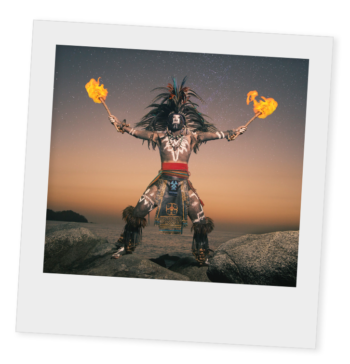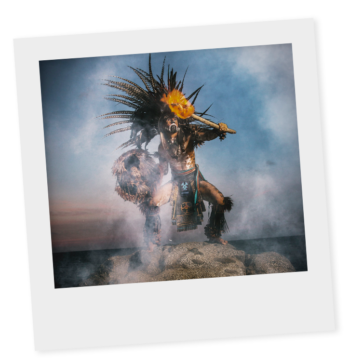An Interview with Tekie, an Aztec Workshop Model
JP Stones talks with Tekie, one of the Aztec Workshop models, about his beliefs and traditions. Oh, and finding dead eagles in the jungle.
WHAT NATION DO YOUR TRACE YOUR ETHNICITY BACK TO?
My father was born to Chichimeca parents. His people were originally a nomadic people who lived in the north of Mexico. The reputation as fierce warriors was enhanced when they resisted Spanish intrusions into their territory. Only a few thousand Chichimecas remain. many of whom live in the state of Guanajuato.
My mother was born in Nayarit, north of Sayulita, in a town called Ixtla. She is of Huichol descendance, though she refers to herself as Wixáritari (which translates as ’the people’ in her native language). The Huichol believe they originated in the state of San Luis Potosi, over 15,000 years ago. Many Huichol still journey back to their ancestral homeland to perform Peyote ceremonies. This has earned them the moniker of ‘Keepers of the Peyote’.
So, I am a mestizo in a sense. A mix of two indigenous groups.

The traditional ceremonies are everything to me. Without them, I would not know who I am. They fill my heart with the energy I need to live.

HOW WERE YOU INTRODUCED TO THESE TRADITIONS?
I was brought up in a very traditional community, so it was always around me really. But it wasn’t until I was 18 years old that one of the elders became my teacher. He taught me about the sacred dances, such as the ‘Mitote’ dance, as well as the meaning of the Temazcal and Peyote ceremonies. I was fascinated from the beginning and have kept practicing and increasing my understanding of the myths that have shaped, not just Huichol, but many indigenous communities in Mexico.
WHAT ROLE DO THEY PLAY IN YOUR DAILY LIFE?
The traditional ceremonies are everything to me. Without them, I would not know who I am. They fill my heart with the energy I need to live.
HOW IMPORTANT IS IT TO SHARE YOUR CULTURE AND TRADITIONS?
I believe that if you can help others – then you should. These ceremonies are ancient and have great wisdom. They have stood the test of time and many Westerners are starting to understand their healing powers. They have definitely helped shape my life, and I really believe they can help others.
I also know that not all indigenous communities feel this way. They believe that if they open up to outsiders, it will dilute their own traditions. And I understand that fear: protecting these traditions is important. But I feel we can protect and share at the same time. The more people know how special this culture is, the more they will want to help protect it.
That is why I enjoy taking part in the workshops so much. I get to do what I love, create art and make people aware of this ancient culture
WHERE DO YOU FIND THE FEATHERS IN YOUR HEADDRESS?
There are a few ways you can get feathers. The first ones I owned were given to me by my teacher. But I have also found many on the floor when walking in the jungle. My ‘chemole’ (shield) has a young eagle on it. He had fallen from a tree and died.
In the past, there used to be a spiritual cleansing process people would go through, where you would fast and pray for days. After completing this, you could go and hunt a bird. But that doesn’t really happen anymore.
Most of the feathers I have, I bought from others in the community. Some from as far away as Canada!
Once I have the feathers it can take me a month or more to create the copilli (headdress) to place them in.
HOW DOES DANCING MAKE YOU FEEL?
It makes me feel like a different person. I seem to harness an energy and power when I dance. It’s like an antenna that connects me to the stars and my ancestors. I go into a trance and forget about the world around me.
Book an Aztec Workshop today, or contact JP to find out more about the Cultural Workshops project.


No Comments